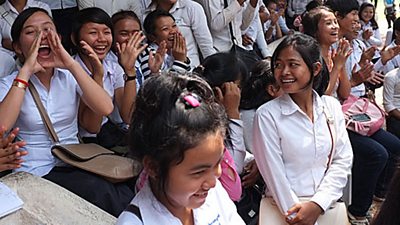Downloads
To reinforce understanding of malaria prevention among our target audiences ±«Óătv Media Action used film and public service announcements (PSAs or spots) on Cambodian TV and radio. The broadcasts were also designed to increase demand for early diagnosis and treatment.
Publication date: September 2013
±«Óătv Media Action was funded by the Global Fund Round 9 to create 11 TV and radio PSAs (spots) and a film. The PSAs were broadcast between June and November in 2011 and 2012 on TV5 and local radio. The film was distributed by the Women's Media Centre using mobile video units in “media-dark” areas. The project aimed to reduce mortality from malaria by raising awareness and encouraging health-seeking behaviours. Programmes also sought to contain the spread of drug-resistant malaria parasites by supporting community mobilisation and advocacy. The primary audiences were male migrant workers who travel to rural areas where malaria is endemic and farmers aged 15–49, with health workers a secondary audience.
Research approach
To evaluate this programme, focus group discussions (FGDs) were conducted across four provinces with participants from either primary or secondary target audiences. Participants were recruited through purposive sampling (in which the researcher chooses the people included in the sample) and snowball sampling (where study subjects recruit future subjects from among their acquaintances). They were also screened to ensure they had been exposed to at least one of the project's outputs. Research was conducted in provinces with a high number of workers who travel to malaria-endemic areas, as well as in malaria-endemic areas. Areas included in the research had access to ±«Óătv Media Action film, TV and radio spots.
Key findings
- Participants thought the ±«Óătv Media Action PSAs and film were engaging and informative. Though much of the information contained in the broadcasts was felt to support existing knowledge, it was welcomed as clear and professional.
- There was evidence that participants acquired knowledge from the broadcasts. This included that malaria testing and treatment is free, and as a result some participants said they would no longer buy malaria medicine before going for a blood test. However, many did not realise that failing to finish treatment could lead to drug-resistant malaria.
- Drug resistance was felt to be a confusing term and any future outputs should consider ways to communicate this concept more effectively.
- Participants felt storylines were relevant and reflected the lives of target audiences.
- Both village malaria workers (VMWs) and people who work in forests felt that the spots supported the role of VMWs.
- Examples of behaviour change as a result of exposure to the PSAs were found, in particular an increased use of insecticide treated nets among workers travelling to forested areas.
- There were some problems reaching target audiences in remote locations that could be solved by working with new or additional broadcasting partners.
Project context
In line with a global decline in recent years, malaria incidence in Cambodia is 0.9%, down from 2.6% in 2007 and 4.4% in 2004. However, malaria remains a serious and often fatal disease, which appears to be moving south and east in the country.
Malaria is particularly prevalent in heavily forested areas, leaving the population there at a higher risk of infection. This is compounded by the fact that these forested areas (largely found in north-eastern Cambodia) are home to large numbers of ethnic minority groups who lack access to malaria treatment and prevention services. While there has been a recent improvement in the use of malaria prevention measures, in 2010 only a third of those working in forested areas reported sleeping under a net while working in the forest.
Similarly, although the number of villages with trained village malaria workers has increased and most villagers are aware of treatment options for malaria, not all villagers commit to taking the entire course of treatment that is necessary for it to be effective. This ±«Óătv Media Action project aimed to reinforce existing messages about malaria prevention through the use of insecticide-treated nets, long-lasting insecticidal nets and early diagnosis and treatment. The programme also set out to support health workers who provide diagnoses and treatment in remote villages.
Implications and impact
With malaria cases in Cambodia declining, this project aimed to raise awareness among at-risk communities and reinforce knowledge about malaria prevention, diagnosis, and treatment. The research has shown that although most people working in forested areas are likely to have knowledge about malaria treatment, they appreciated messages that reinforced this. It was particularly useful to those who had been resident in malaria-endemic areas for a shorter period of time and therefore had a lower awareness of the issues. Future projects might consider clarifying the meaning and consequences of drug-resistant malaria as this was a source of confusion for some participants.
In future ±«Óătv Media Action could also consider broadcasting on a TV station with greater broadcasting power than TV5, which struggled to reach certain areas. The project could also increase co-operation with additional radio stations in order to extend message reach.
“I learned to pay more attention to malaria and now know to prepare things like treated nets when going far (to the forest).” - Worker, malaria-endemic area
